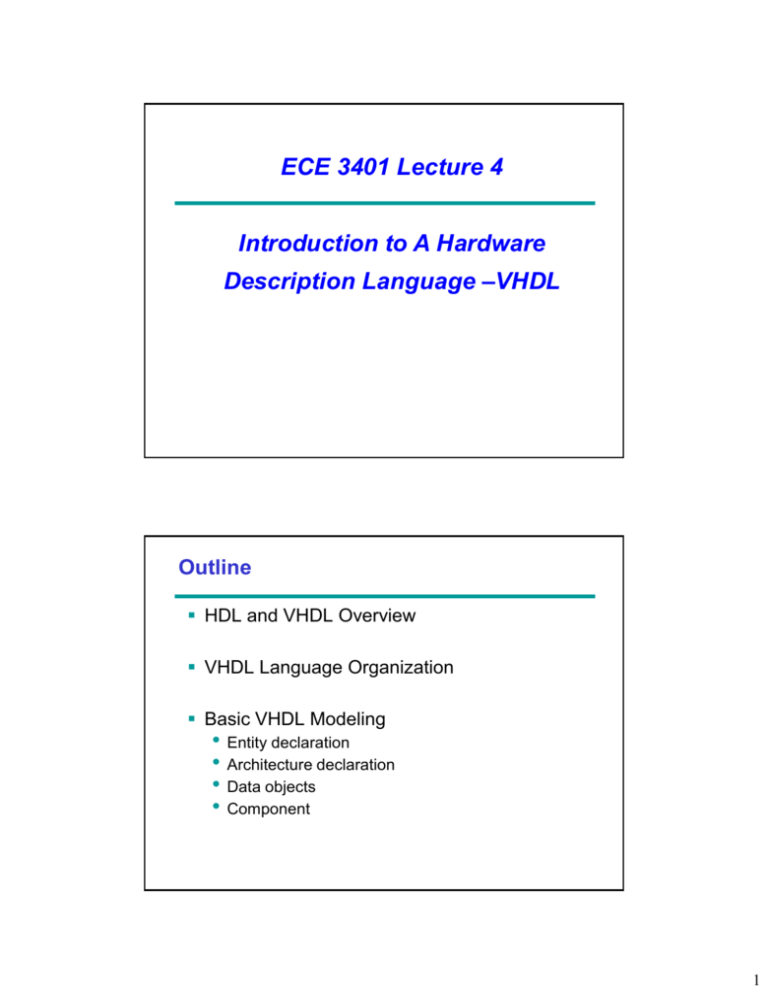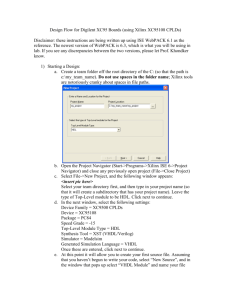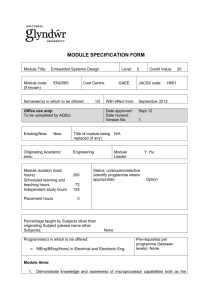Ashenden's VHDL
advertisement

ECE 3401 Lecture 4 Introduction to A Hardware Description Language –VHDL Outline HDL and VHDL Overview VHDL Language Organization Basic VHDL Modeling • Entity declaration • Architecture declaration • Data objects • Component 1 HDL-Overview What is Hardware ? Hardware Description Language (HDL) = "Programming" language for modeling of (digital) hardware. HDL: VHDL (very-high-speed integrated circuits (VHSIC)), Verilog Application of HDL HDL offer design reuse capabilities. • The corresponding HDL model can be re-used in several designs/projects. • Frequently needed function blocks (macros) are collected in model libraries. 2 Range of Use VHDL – Overview Very-High-Speed Integrated Circuit (VHSIC) Hardware Description Language (VHDL): • Modeling of digital systems • Concurrent and sequential statements • Machine-readable specification • Man- and machine-readable documentation International Standards: • IEEE Std 1076-1987 - IEEE Std 1076-1993 3 VHDL Information Reference Books for VHDL: • • • • • Peter J. Ashenden, “The Student’s Guide to VHDL (2nd Edition),” Morgan Kaufmann. Peter J. Ashenden, “The Designer's Guide to VHDL (2nd Edition)”, Morgan Kaufmann. J. Bhasker "A VHDL Primer (3rd Edition)", Prentice Hall Yalamanchili "Introductory VHDL from Simulation to Synthesis" D. L. Perry “VHDL Programming by Example" McGrawHill Useful web site for VHDL: • • http://www.eda.org/rassp/vhdl http://www.peakfpga.com/vhdlref/index.html Concepts of VHDL Execution of assignments: • • Sequential: Executed one after another, like in software programming languages. Can override the effects of previous statements. Concurrent: Active continuously. The order of statements is not relevant. Suited to model the parallelism of hardware. Abstraction: description of different parts of a system. • On every abstraction level, only the essential information is considered, nonessential information is left out. 4 Abstraction levels in Digital Design Behavioral level: • Functional description of the model is outlined. • No system clock, signal transitions are asynchronous with respect to the switching time. • Simulation only, but typically not synthesizable. Abstraction levels in Digital Design Register level (RTL): • • • The design is divided into combinational logic and storage elements. Storage elements (Flip-Flops, latches) are controlled by a system clock. Synthesizable. Logic level: • The design is represented as a netlist with logic gates (AND, OR, NOT,...) and storage elements. Layout level: • • The different cells of the target technology are placed on the chip and the connections are routed. After the layout has been verified, the circuit is ready for the production process (submitted to manufacturing factory for chip fabrication). 5 Information Content of Abstraction Levels Abstraction levels and VHDL 6 Behavioral Description in VHDL o <= transport i1 + i2 * i3 after 100 ns; The function can be modeled as a simple equation (e.g. i1+i2*i3) plus a delay of 100 ns. Behavioral Synthesis Only very simple behavioral models are synthesizable. Applications: design of RAM cells for the target technology, where only the generic parameters (width, depth, number of ports, (a)synchronous,...) need to be specified. Advantages • • • • Explore Architectural Tradeoffs Automatic generation of state machines Fewer lines of VHDL code Faster simulation than RTL • • • No timing information Tools are not mature May not be appropriate for non-algorithmic designs Disadvantages 7 RTL Synthesis RTL synthesis implements all functionality within a single clock cycle Behavioral synthesis automatically allocates the functionality across multiple clock cycles Behavioral/RTL Synthesis 3 From Synopsys Behavioral Compiler Presentation 8 Register Transfer Level in VHDL Functional behavior is modeled with registered process (clocked process) and combinational process. RTL VHDL code contains some sort of structural information in addition to the functional behavior. Gate Level in VHDL Contains a list of the gates components (e.g. ND2, NR2, AO6). Each single element of the circuit (e.g. U86) is instantiated as a component (e.g. ND2) and connected to corresponding signals (n192, n191, n188). 9 VHDL Language & Syntax (General) ------------------------------------ Example VHDL Code -----------------------------------signal mySignal: bit; -- an example signal MYsignal <= '0', '1' after 10 ns, '0' after 20 ns, '1' after 30 ns; Signal assignment: ' <= ' User defined names: • Letters, numbers, underscores. • Start with a letter. • No VHDL keyword may be used. • Case insensitive -- start with '0' -- and toggle -- every 10 ns List delimiter: ',' Statements are terminated by ';' (may span multiple lines) Comments: '--' until end of line VHDL Language & Syntax (Identifier) MySignal_23 -- normal identifier Normal Identifier: rdy, RDY, Rdy -- identical identifiers Letters, numbers, underscores vector_&_vector -- X : special character Case insensitive. last of Zout -- X : white spaces idle__state -- X : consecutive underscores The first character must be a letter. 24th_signal -- X : begins with a numeral The last character cannot be an underscore. open, register -- X : VHDL keywords • • • • • • \mySignal_23\ -- extended identifier \rdy\, \RDY\, \Rdy\ -- different identifiers \vector_&_vector\ -- legal \last of Zout\ -- legal \idle__state\ -- legal \24th_signal\ -- legal \open\, \register\ -- legal No two consecutive underscores. VHDL reserved words may not be used as identifiers. Extended Identifier (VHDL93) • Enclosed in back slashes • Case sensitive • Graphical characters allowed • May contain spaced and consecutive underscores. • VHDL keywords allowed 10 Legal and Illegal Identifiers Legal Identifiers: Uconn_huskies ECE_252 Sel6B Illegal Identifiers: _time_is_9am -- an identifier must start with a letter. 8thsemester -- an identifier must start with a letter. Homework#1 -- letter, digits, and underscore only. final_ _example -- two underscore in succession not allowed Entity -- keyword cannot be used as identifier Time_out_ -- last character cannot be an underscore. VHDL Reserved Words abs disconnect label package sla access downto library port sll after else linkage postponed sra alias elsif literal procedure srl all end loop process subtype and entity map protected then architecture exit mod pure to array file nand range transport assert for new record type attribute function next register unaffected begin generate nor reject units block generic not rem until body group null report use buffer guarded of return variable bus if on rol wait case impure open ror when component in or select while configuration inertial others severity with constant inout out shared xnor signal xor is 11 VHDL Structural Elements Entity: description of interface consisting of the port list. • The primary hardware abstraction in VHDL, analogous to a symbol in a block diagram. Architecture: description of the function of the corresponding module. Process: allows for a sequential execution of the assignments Configuration: used for simulation purposes. Package: hold the definition of commonly used data types, constants and subprograms. Library: the logical name of a collection of compiled VHDL units (object code). • Mapped by the simulation or synthesis tools. Basic VHDL Concepts Interfaces Behavior Structure Test Benches Analysis, elaboration, simulation Synthesis 12 A VHDL Design Unit consists of an Entity Declaration and an Architecture Body. Entity Declaration: Names entity and defines interfaces between entity and its environment. ENTITY entity_name IS PORT ( name_list : mode type); END entity_name ; Architecture Body: Establishes relationship between inputs and outputs of design. ARCHITECTURE body_name OF entity_name IS -- declarative_statements BEGIN -- activity_statements END body_name; Entity statement entity HALFADDER is port( A, B: in bit; SUM, CARRY: out bit); end HALFADDER; entity ADDER is port( A, B: in integer range 0 to 3; SUM: out integer range 0 to 3; CARRY: out bit ); end ADDER; Interface description Port clause identifies ports used by "entity" to communicate with its environment. Port signals • Data types: bit, int, ... • Signal width: 0 to 3 • Signal direction: in, out, ... 13 Architecture Body Statement entity HALFADDER is port( A, B: in bit; SUM, CARRY: out bit); end HALFADDER; An architecture defines an entity's behavior from a simulation point of view. Implementation of design -- Architecture body Always connected with a specified -- "Hadd" is user defined name entity • One entity can have several architecture Hadd of HALFADDER is begin architectures SUM <= A xor B; • Entity ports are available as CARRY <= A and B; signals within the architecture. end architecture Hadd; Contains concurrent statements. Architecture Body Structure -- architecture Body architecture EXAMPLE of STRUCTURE is -- Declarative part subtype DIGIT is integer range 0 to 9; constant BASE: integer := 10; signal DIGIT_A, DIGIT_B: DIGIT; signal CARRY: DIGIT; begin -- Statement part DIGIT_A <= 3; SUM <= DIGIT_A + DIGIT_B; DIGIT_B <= 7; CARRY <= 0 when SUM < BASE else 1; end EXAMPLE ; Declarative part: • data types • constants • additional signals ("actual" signals) • components • ... Statement part (after 'begin'): • signal assignments • processes • component instantiations • all concurrent statements that can be placed within the statement part.. 14 Example Write a VHDL code for the circuit shown below. The inputs to the circuit are x1, x2, x3, and the output is f ? Example: VHDL code ENTITY example1 IS PORT (x1, x2, x3: IN BIT; f: OUT BIT); END example1; ARCHITECTURE logicFunc OF example1 IS BEGIN -- Architecture statement region f <= (x1 AND x2) NOR (NOT x2 AND x3); END logicFunc; logicFunc: user-defined name ● 15





